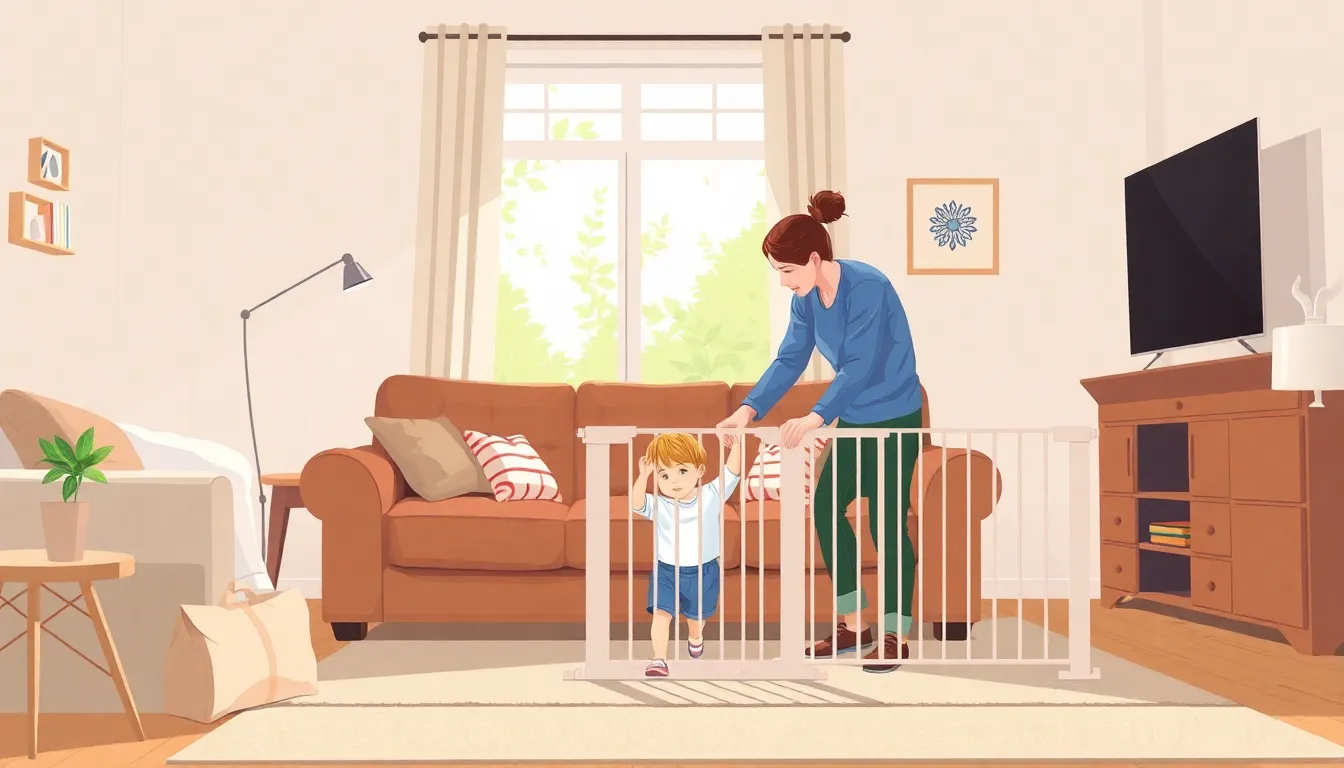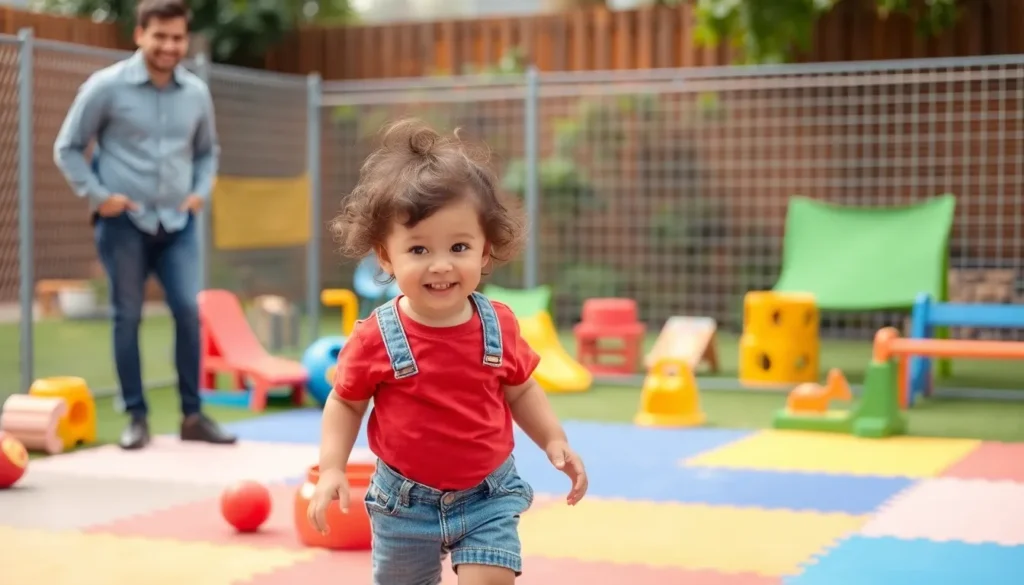Navigating the world with a toddler is like trying to herd cats—adorable, chaotic, and often downright dangerous. With tiny explorers on the loose, every corner of the house can turn into a mini adventure or a potential disaster. That’s where toddler safety tips swoop in like superheroes, ready to save the day (and maybe a few broken bones).
Table of Contents
ToggleUnderstanding Toddler Safety
Understanding toddler safety involves recognizing the various hazards in a child’s environment. Parents and caregivers face the challenge of keeping inquisitive toddlers safe. Such challenges arise from their natural curiosity and desire to explore.
Creating a safe home environment starts with securing large furniture. Anchor bookshelves and dressers to walls to prevent tipping. Lock cabinets and drawers that contain harmful substances or sharp objects.
Childproofing electrical outlets is another necessary step. Install safety covers on unused outlets to reduce the risk of shock. Use surge protectors to safeguard devices from power surges.
Outdoors also presents unique safety considerations. Fencing around pools prevents accidental drowning. Supervision near streets and driveways ensures toddlers stay safe from traffic.
Using age-appropriate toys plays a vital role in safety. Choose toys that meet safety standards and do not pose choking hazards. Regular checks for broken or damaged toys help maintain a safe play environment.
Educating toddlers about safety can be beneficial. Teaching them basic rules, such as not touching hot surfaces or running in crowded places, fosters awareness. Reinforcement and practice help establish safe habits.
Maintaining vigilance can significantly reduce accidents. Parents and caregivers should consistently monitor toddlers, especially in unfamiliar settings. Establishing routines that include safety checks, like looking for potential hazards, can help.
Understanding toddler safety involves proactive measures and consistent supervision. Taking these steps contributes to a safer environment and better peace of mind for caregivers and families.
Home Safety Tips

Creating a safe home environment for toddlers is essential. Parents and caregivers must be vigilant in identifying and mitigating potential hazards.
Baby-Proofing Your Home
Start with securing heavy furniture. Utilize brackets or anchors to prevent tipping. Install baby gates at stairs and doorways. Childproof electrical outlets using safety covers. Remove or store away small items that pose choking hazards, such as coins and small toys. Ensure sharp objects, like scissors and knives, are kept out of reach. Keep cleaning supplies and medications locked away in cabinets. Cover corners of furniture with cushioned protectors to reduce injury risks. Adopting these measures creates a safer, more secure space for exploration.
Safe Sleep Practices
Establishing safe sleep routines protects toddlers during rest. Place infants on their backs in a crib free of soft bedding, pillows, and toys. Use a firm mattress covered with a fitted sheet. Ensure cribs meet the latest safety standards. Avoid bed-sharing to reduce the risk of suffocation. Room-sharing is a safer alternative for the first year. Monitor room temperature to prevent overheating. Utilize sleep sacks instead of loose blankets. Regularly inspect sleeping areas for hazards, ensuring a safe sleep environment. These practices contribute to a secure sleeping arrangement for young children.
Outdoor Safety Tips
Outdoor play encourages physical activity and curiosity. Implementing safety measures ensures a secure environment for toddlers.
Supervision Strategies
Consistent supervision remains crucial during outdoor activities. Parents and caregivers should stay within arm’s reach when toddlers play. Engaging in their playtime invites interaction and adds an extra safety layer. Setting a designated boundary helps toddlers understand their play area limits. Alertness to potential hazards allows adults to intervene quickly, preventing accidents. Regularly discussing safety rules reinforces expectations, fostering awareness in young children.
Safe Play Areas
Creating safe play areas reduces the risk of injuries. Use soft surfaces like grass or rubber mats under play equipment to cushion falls. Installing safety gates around playgrounds and patios prevents unsupervised access to potentially hazardous areas. Additionally, ensuring that equipment is age-appropriate minimizes risks associated with inappropriate play. Regular inspections of outdoor toys and equipment help identify any wear or hazards, further enhancing safety. Choosing enclosed spaces for play restricts toddlers from wandering into danger and promotes secure exploration.
Travel Safety Tips
Traveling poses unique challenges for toddlers. Safety measures ensure a secure journey every time.
Car Seat Essentials
Car seats serve as a crucial safety device. Selecting the right car seat based on a toddler’s age, weight, and height remains essential. Many parents opt for rear-facing seats during the early years, following recommendations from safety experts. Installation requires adherence to manufacturer guidelines for optimal protection. Regular checks ensure the car seat remains secure. Avoid switching to a booster seat too soon; children should meet height and weight requirements. Always rely on seat belts when transitioning from a car seat to regular seating. Lastly, keeping the car stocked with safety supplies, like a first-aid kit, enhances preparedness during travel.
Traveling with Toddlers
Traveling with toddlers requires proactive planning. Packing snacks and toys helps keep them entertained during long journeys. Many families choose to schedule frequent breaks to allow toddlers to stretch and explore. Parents should prepare for travel delays by bringing along extra supplies. Communicating safety expectations ahead of time fosters understanding. Installing a travel harness or using child leashes in crowded places can enhance control. Consider booking accommodations that provide child-friendly amenities. Familiarizing toddlers with new environments promotes comfort and reduces anxiety. Staying vigilant during excursions ensures all adventures remain safe and enjoyable.
Emergency Preparedness
Creating an emergency plan is crucial for families with toddlers. Parents should identify potential emergencies, such as fires, natural disasters, or medical situations. Preparing a family emergency kit ensures essential items are readily available. It’s important to include supplies like first-aid items, water, non-perishable food, flashlights, and extra batteries.
Regularly conducting drills helps toddlers become familiar with emergency procedures. Engaging in discussions about safety encourages them to understand what to do in different situations. Practicing fire drills, for instance, demonstrates the quickest exit route from home.
Parents must also establish contact information and emergency numbers in an accessible location. Make sure toddlers learn important phone numbers, like a caregiver’s or family member’s. Using visible reminders can reinforce memory and awareness.
Creating a safe meeting place outside the home offers reassurance in emergencies. Designate a specific location for family members to gather if evacuation occurs. It supports accountability and decreases confusion during stressful moments.
Having age-appropriate books and activities that explain emergencies can help toddlers cope. Storybooks featuring familiar characters can provide a gentle introduction to potential fears. Explaining concepts in relatable terms calms anxiety and builds confidence.
Regularly reviewing and updating the emergency plan ensures it remains relevant. Families should adapt procedures as toddlers grow and their needs change. Flexibility is vital for maintaining a thorough approach to disaster preparedness. Keeping safety as a priority fosters security for both caregivers and children.
Ensuring toddler safety is a continuous journey that requires vigilance and proactive measures. By implementing effective safety strategies at home and during outings, caregivers can create a secure environment that nurtures exploration while minimizing risks. Regularly reviewing safety practices and adapting them to a toddler’s growing abilities is crucial.
Encouraging open discussions about safety and involving toddlers in understanding their surroundings fosters awareness and responsibility. With the right precautions in place, families can enjoy peace of mind while allowing their little ones to discover the world around them safely. Prioritizing safety today paves the way for a brighter and more secure tomorrow.






